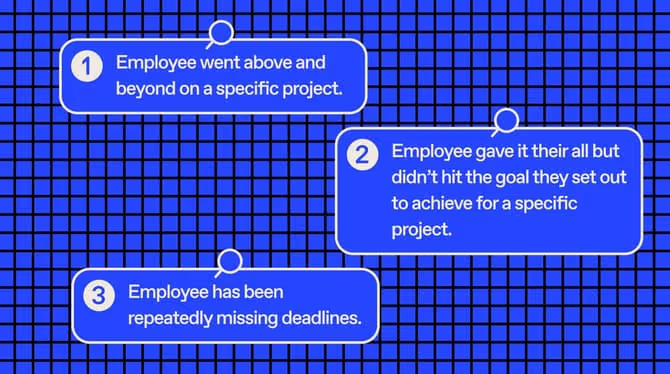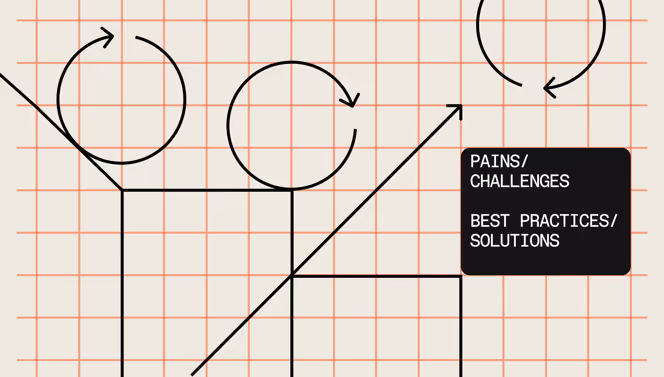Feedback: A non-negotiable in the continuous performance management process

Discover Workleap Officevibe's benchmark report on 12 key employee engagement metrics

When it comes to modern management, traditional annual performance reviews aren't cutting it. Managers find themselves caught in a loop of once-a-year assessments that miss the beat of real-time progress, which slows down employee growth. Sound familiar?
That's where continuous performance management comes in to shake things up. It's not just a shift in terminology — it's an evolution in how we manage, motivate, and develop our teams.
And at the heart of continuous performance management lies one crucial thing: feedback. More frequent and more of it.
What is continuous feedback?
Continuous feedback is all about ongoing communication for the sake of improvement. It's an approach that promotes transparent and constructive conversations between managers and employees on an ongoing basis, rather than waiting for the annual performance review process to take place to discuss employee performance.
By moving away from traditional performance appraisals, continuous performance management systems create feedback loops where everyone involved — whether giving or receiving feedback — participates in creating solutions.
Benefits of continuous feedback in performance management
Feedback strengthens communication across the board, enhances employee engagement, and drives professional development. Regular feedback within continuous performance management is even better for rapid problem-solving — something newer generations of employees respond well to!
Improved communication
Effective communication within the workplace is essential for any team to achieve success, and regular feedback facilitates constant dialogue between managers and employees.
Regular one-on-ones allow managers to discuss ongoing projects, align expectations, and address concerns. But these meetings are equally there for employees to raise flags, ask for clarity, or request more support.
Every feedback moment is an opportunity for both parties to feel heard and to create a shared understanding. And when you improve communication, you improve performance.
Higher employee engagement
Employee engagement can sound like an HR buzzword, but it's genuinely at the center of great performance. When employees feel engaged, they take pride in their jobs and are more motivated to do good work.
Feedback nurtures engagement even when it's about improving areas where employees experience difficulty, too; 94% of corrective feedback recipients feel it makes a positive impact on their performance.
After all, it makes all the difference when employees know they are being supported, and have a better understanding of how to succeed.
Quicker problem resolution
Challenges can arise in myriad ways in the workplace — it's how swiftly they're addressed that makes all the difference. With a continuous performance feedback system, managers can identify and resolve issues before they snowball.
Say there's a perceived unfairness with task distribution within a team, causing frustration for some team members. Timely feedback can bring this issue to light and get it sorted before it escalates further and negatively impacts team dynamics. There are various ways to deal with work conflict. The key is to tackle it right away.
The importance of feedback in a continuous performance management system
Of course, there is no one-size-fits-all approach to continuous performance management. As a manager, you'll have to make it your own to fit the individual employees that make up your team. But ongoing feedback is the one unchanging variable that sees your employees win. Here's why:
Drives employee development
When a 1/3 of employees have to wait 3 months to get feedback on tasks, they miss the window of opportunity for immediate improvement. Inconsistent or infrequent feedback, such as with traditional annual performance reviews, can only do so much with employee development.
Continuous performance management offers instant feedback that allows for more immediate assistance. It helps managers design more agile and responsive development plans, in tune with what employees need at any given point in time.
Keeps productivity at ideal levels
Employees who receive frequent feedback have a better understanding of not only their strengths but also of areas for improvement, so they can focus on tasks that align with their skill sets and maximize their productivity.
Likewise, when managers know where employees stand, they are better able to support them in their workload. Employees who share feedback with their managers can communicate when they are overworked or when they can take on more.
Boosts employee retention
Retention isn't just down to salaries and benefits — employees also value the work environment they are a part of. It's important to invest in a culture in which employees feel they can thrive.
Feedback within continuous performance management has a huge impact on retention because it emphasizes recognition and growth, which boosts employee satisfaction, and, in turn, builds employee loyalty. The proof is in the numbers: companies that incorporate recognition within their management systems see a 31% decrease in voluntary turnover.
Creates alignment
When communication between managers and employees is an ongoing affair, there are no question marks. Continuous performance management ensures that everyone is on the same page when it comes to goals, both individual and organizational.
When managers check in and provide feedback regularly to their teams, they can also swoop in more efficiently where there are problems. Real-time feedback allows for quicker course correction and realignment of priorities where necessary.
Improved team collaboration
Feedback isn't just between managers and employees — it should arise between peers, too. Teams thrive on collaboration, and a continuous performance feedback system is the red thread that connects collaboration between peers.
Workleap Officevibe data shows that 82% of employees value their colleagues' input, so by creating a feedback loop that can collect feedback from a variety of perspectives and regularly assess team dynamics, continuous performance management becomes something everyone can participate in.
Builds stronger employee-leadership relationships
Modern workplaces are seeing hierarchical gaps flatten between employees and leadership. Because continuous performance management creates both top-down and bottom-up feedback, it's a system that fosters a culture where leaders become approachable mentors.
This creates a more human and symbiotic relationship dynamic that builds trust toward leaders, making employees more receptive to their guidance.
6 feedback best practices to include in your continuous performance management process
From the more formal one-on-ones to seamless moments of praise between meetings, make sure that your continuous performance management system includes a variety of feedback practices:
Hold regular one-on-one meetings
A fundamental aspect of continuous performance management is regular one-on-one meetings. These are structured sessions that carve out dedicated time for managers to connect with each team member individually. The aim of one-on-ones isn't just about project performance discussions but about general professional development and wellness, too.
One-on-ones shouldn't be reserved for the end-of-year performance review process. Make sure to set aside time to meet with employees regularly, even if it's for just 15 or 30 minutes. This demonstrates to employees that ongoing dialogue is always a priority.
{emphasize}Implementing a bi-weekly or monthly one-on-one meeting structure can feel tedious, but dedicated employee experience tools include features for setting up and automating these regular check-ins, ensuring that feedback is a consistent part of the managerial routine.{emphasize}
Offer specific feedback
There's nothing worse than vague feedback. When feedback is too generic, it loses its effectiveness. The trick is to be specific, pointing out precisely what employees did well or where improvement is needed. This way, employees know exactly what to keep doing or what to change.
Instead of saying, "Great job on the project," say, "Your detailed analysis in the project presentation was excellent. It brought a fresh perspective to the team."
{emphasize}Managers can find many techniques for delivering feedback with impact. Use them to your advantage to ace continuous performance management!{emphasize}
Set clear action items and follow-ups
Feedback without the next steps is incomplete. After discussing feedback, good or bad, it's essential to outline clear action items and when to follow up, which holds every accountable. Continuous performance management is about creating an ongoing plan for improvement.
This could look like setting new short-term goals, booking specific training, or assigning projects that align with the employee's developmental needs or aspirational goals.
{emphasize}If feedback suggests a need for improved project management skills, the action item could be to enroll in a project management training program, and the follow-up could involve an assessment of progress in one month.{emphasize}
Give recognition and praise when it's deserved
While constructive feedback is essential, so is acknowledging a job well done. Recognition is a powerful motivator — don't underestimate how much it can boost motivation! Continuous performance management is just as much about regular praise as it is about feedback.
By regularly recognizing and appreciating employees for their achievements, even in small ways, you're helping foster a positive work environment that employees want to be a part of.
{emphasize}Employee recognition can include small but meaningful tokens of praise or more public shout-outs depending on your team member's communication style.{emphasize}
Offer training and development
Continuous improvement requires continuous learning, so managers need to actively support the training and development of their team members based on the feedback received.
Professional development can involve a variety of activities aligned with individual career goals, like in-person workshops, e-learning courses, or shadowing days with more senior members.
{emphasize}If feedback highlights a need for enhanced leadership skills, the manager can recommend leadership training programs or connect the employee with a mentor who excels in leadership.{emphasize}
Make feedback a two-way street
Effective feedback is never a one-sided conversation. Continuous performance management considers everyone's perspective. That means managers need to encourage employees to voice their opinions, concerns, and ideas too, to build mutual respect and participation.
{emphasize}Not everyone experiences the same ease when it comes to speaking freely. Anonymous feedback tools can be a great addition to collecting unbiased feedback amongst peers, such as through online pulse surveys or via a suggestion box.{emphasize}
Leverage tech for ongoing feedback and improve employee performance tenfold
Technology serves as a true ally in the continuous performance management journey — we're in the digital age after all.
Continuous performance management software can automate the feedback loop, ensuring that communication isn't put on the back burner in the hustle of day-to-day operations, making continuous performance management that much more accessible and efficient.
Continuous performance management is one thing you shouldn't take shortcuts on. When managers are equipped with the right tools, they're then able to focus on what they do best — leading their teams! And employees can thrive.
Want to learn more about continuous performance management? Read on for more insights!
Give HR and managers the clarity, confidence, and connection to lead better every day.


%20(1).avif)


.avif)
.avif)








